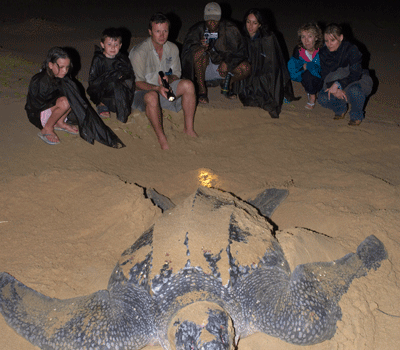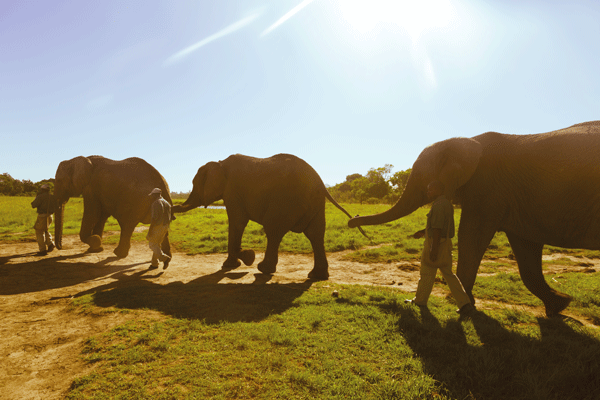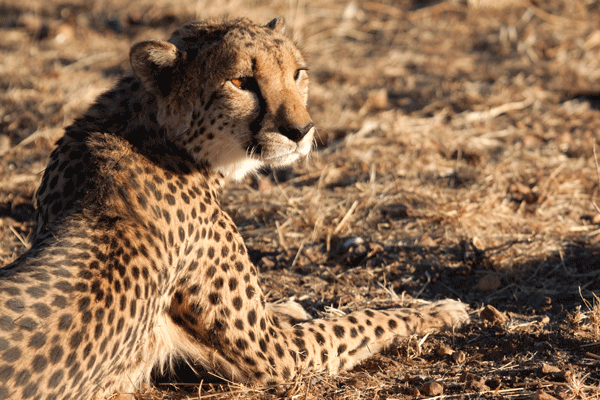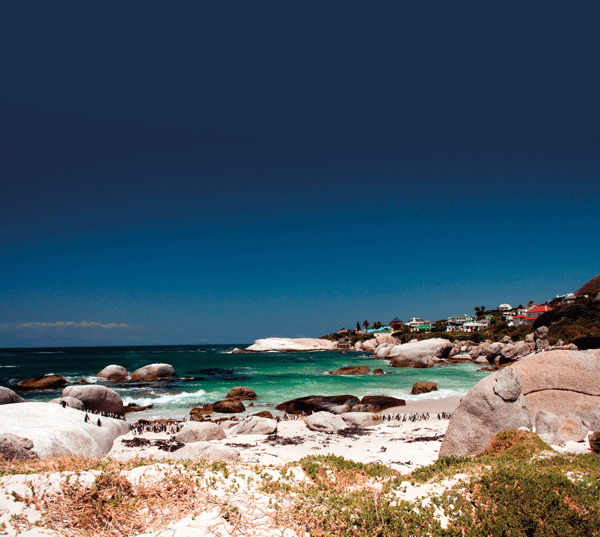An encounter with a wild animal can be an exhilarating and profound experience. Meghan Spilsbury shares some of the best places to come face-to-face with other species
Turtle power
Sitting patiently on the beach in the bright moonlight, we eagerly scoured the shoreline for any signs of activity. It didn’t take long to spot the telltale mini-bulldozer-like tracks… And, then, there she was – a leatherback turtle ready to lay her eggs in a freshly dug nest below the dunes.
Estimated to weigh around 400 kg, she was much bigger than I’d expected, yet still vulnerable. I felt deep respect for this brave creature forced to negotiate both tide and predator in her quest to deliver her precious cargo.
We crouched down to get a closer look without disturbing her. The turtle’s metre-wide shell glistened in the soft light, as cleansing ‘tears’ (actually a means of ridding her body of excess salt) trickled from her eyes. Each laying season, 70 to 80 female turtles return to the protected shoreline of iSimangaliso Wetland Park. I felt privileged to witness just this one nurturing mother perform her primal reproduction ritual.
We were, at first, encouraged by the sheer number of eggs, but our guide quickly dispelled our optimism – only one out of about 100 hatchlings ever reaches maturity. Their relatives may have wandered the world’s oceans for more than 100 million years, but the leatherback turtles are falling victim to human development and now sit firmly on the vulnerable-species list.
iSimangaliso Wetland Park
Northern KwaZulu-Natal
035 590 1633
www.isimangaliso.com
Larger than life
This wildlife encounter is sure to keep your adrenalin pumping and your ego in check. To walk beside the world’s largest land mammal is a humbling experience – something made possible at Plettenberg Bay’s Elephant Sanctuary. Here, visitors are invited to interact with a number of elephants, see where they sleep, and learn about their unique anatomy and their natural behavioural patterns.
Any concerns about the authenticity of the experience will soon be allayed. It only takes a few moments near these behemoths to realise that – while they may not be roaming free in the wild – they remain wild at heart and are not trained circus performers. The handlers earn the elephants’ trust through the use of positive reinforcement, and it’s fascinating to witness the bonds of friendship forged between human and animal.
For me, the emotional experience of walking hand-in-trunk couldn’t be topped – not even by the opportunity to experience a bareback elephant ride. Simply standing there silently alongside a creature so graceful, so powerful and yet so peaceful and trusting was more than I could ever have asked for.
Elephant Sanctuary South Africa
Plettenberg Bay, Western Cape
044 534 8145
www.elephantsanctuary.co.za
The cat walk
Named after the woman who dedicated her life to conserving cheetahs, The Ann van Dyk Cheetah Centre, situated at the foot of the Magliesberg, is a safe haven for creatures and an education centre for humans. Animal lovers can learn more about cheetahs, as well as the African wild dogs and various other mammals and birds housed here.
Cheetahs were once threatened with extinction in SA (they are still classified as vulnerable worldwide); however, their numbers are increasing locally. This can be largely attributed to the conservation efforts of this nonprofit organisation.
Time your visit right and you may be lucky enough to join the staff on a feeding round or watch the ambassador cheetah on an exercise run. Don’t miss out on a game drive, which offers unique insight into the life of Africa’s fastest land animal, with hands-on guides sharing their personal experiences and in-depth knowledge of the creatures.
Spending the day with these majestic felines and their caretakers will give you a newfound appreciation of the amount of work it takes to ensure the success of a conservation project such as this.
The Ann van Dyk Cheetah Centre
Brits, North West Province
012 504 9906/7/8
www.dewildt.co.za
Penguin party
They may not be able to fly, but they’re exceptional swimmers and skilful anglers. To visit a thriving penguin community right next door to the city, head through to Boulders Beach in Cape Town. Here, hundreds of African penguin breeding pairs nest and then rear their young, in-between fishing excursions into False Bay and beyond.
Boulders, part of Table Mountain National Park, offers a rare land-based haven for the penguins. Although these birds tend to prefer the peace and quiet of islands far away from humans, they seem content to share their home with the specially constructed viewing boardwalk, which offers visitors a close-up look, without disturbing them or their habitat. As cute as they may appear in their tuxedos, don’t be tempted to reach out and touch them though – they’re known for delivering a swift nip.
Five years ago, the conservation status of this species worsened from vulnerable to endangered and population numbers now stand at alarmingly low levels. By paying the entrance fee to visit the park and observe the penguins, you will be helping to conserve them.
Boulders Penguin Colony
Simon’s Town, Western Cape
021 786 2329
www.sanparks.co.za
Photography Gallo/Gettyimages/Thinkstock, AfricaMediaOnline
(This article was first published in the autumn 2015 issue of AA traveller magazine)







